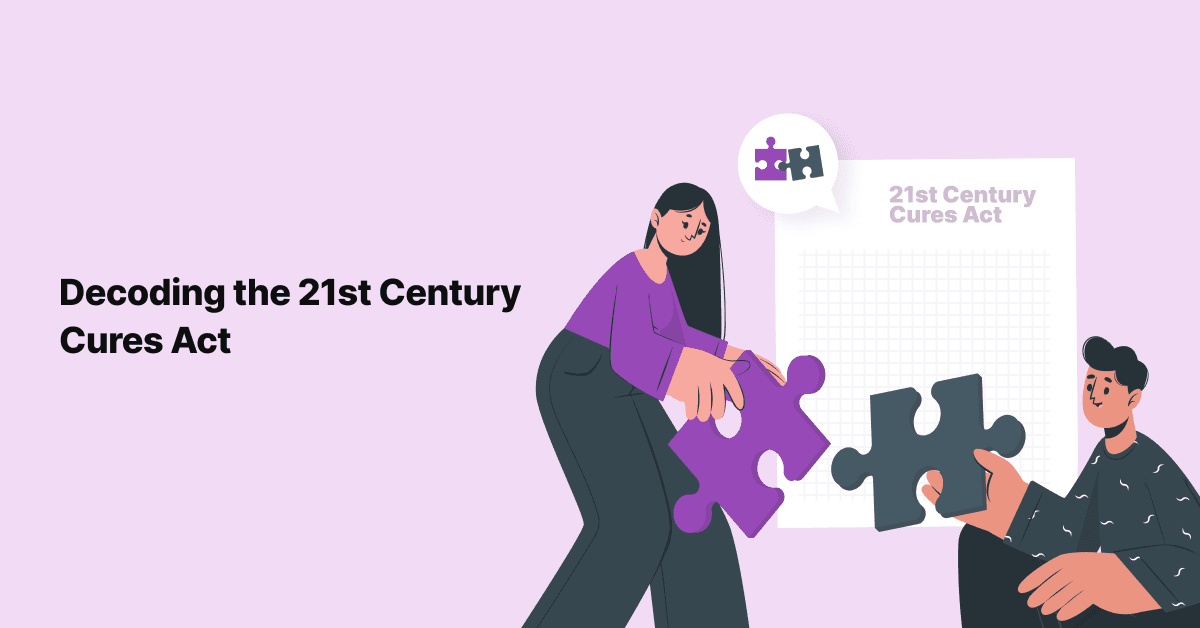
How Is Release of Information (ROI) Changing?
Are you curious about the changes happening in healthcare’s Release of Information (ROI) process?
Gone are the …

Access to health information by the patients or providers has always been a tedious and time-consuming process. While modern technologies did succeed at easing the process, they brought in their own set of challenges. Some challenges related to accessing health information are:
Over the decades, the government and other health organizations have been trying to streamline the process of health information sharing. After much deliberation and planning, the Cures Act was introduced to facilitate a smooth exchange, access, and use of health information, electronically.
In this article, you will learn about:
President Barack Obama signed the Cures Act on 13th December 2016. The Act focuses on eliminating any form of information blocking to provide easy access and exchange of information for the patient, payers, and providers. It also aims to provide faster treatment availability in the market by streamlining the approval of drugs and devices.
The Cures Act would simplify many hurdles and constraints in healthcare; for example, a provider would be able to access the patient’s details, check the patient’s eligibility from a payer, or view the patient’s past medical history without needing to manually or electronically request the respective office. In addition, the Cures Act would easily solve the hassle of faxing, printing, and receiving mail in different formats.
From the patient perspective, they would be able to access all their medical records, including their lab tests, reports, prescription, medical history, irrespective of different providers, and any other health information, all in one place. Furthermore, if the patient wants to switch their payer, they need not provide their medical history and other records physically or request their old payer to send them a fax or email. Instead, the payers would be able to exchange the health data with the patient’s permission directly, saving time for both the patient and the payer.
After being signed into law, the Office of the National Coordinator for Health Information Technology (ONC) and the Centers for Medicare & Medicaid Services (CMS) were put in charge of reviewing the Cures Act and establishing detailed guidelines. These guidelines came to be known as ONC’s Cures Final Rule and CMS Interoperability Final Rule.
The ONC Cures and the CMS Interoperability Final Rule emphasize the following:
ONC’s Final Rule emphasizes streamlining the access and the exchange of Electronic Health Information between patients and providers. The Final Rule focuses mainly on prohibiting information blocking practices by the providers, health IT developers, Health Information Exchanges (HIEs), and health information networks. It has also formulated a set of guidelines, certifications, and requirements for health IT developers related to Application Programing Interface (API) functionality and Fast Healthcare Interoperability Resources (FHIR) adoption.
Check out this article on information blocking to get a detailed understanding of the rule, the exceptions, and the consequences.
The CMS Final Rule focused on encouraging the payers to make health information easily accessible for sharing between the patients and between the payer and provider or between two different payers via the API functionality. Now, this would be achieved through a mobile application or through the practice management system giving the patient the freedom to choose from any desired platform.
As the name suggests, this rule prioritizes the patient by giving them the right to access their health information whenever required.
This rule focuses on the seamless exchange of health data between patients, providers, and payers. It also emphasizes enhancing the prior authorization process through technology and policies.
The 21st Century Cures Act is aimed toward smooth and seamless access and exchange of health information, and this would be advantageous to not only the patients but also the providers and payers.
The 21st Century Cures Act is certainly the next step in the evolution of healthcare!
Join over 3,200 subscribers and keep up-to-date with the latest innovations & best practices in Healthcare IT.

Are you curious about the changes happening in healthcare’s Release of Information (ROI) process?
Gone are the …

Every year huge amounts of data are created by healthcare organizations in the form of lab results, patient …

Effective patient data management stands as a cornerstone for providing optimal care and streamlining …